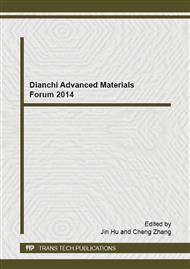[1]
Shigeaki Suganuma, Misa Watanabe, Tuyoshi Kobayashi, Shinichi Wakabayashi, SO2 gas sensor utilizing stabilized zirconia and sulfate salts with a new working mechanism, J. Solid State Ionics 126 (1999) 175–179.
DOI: 10.1016/s0167-2738(99)00220-9
Google Scholar
[2]
W.L. Worrell, Q.G. Liu, A new sulfur dioxide sensor using a novel two-phase solid-sulfate electrolyte, J. Electronic. Chem. 168 (1984) 355–362.
DOI: 10.1016/0368-1874(84)87109-9
Google Scholar
[3]
C.M. Mari, M. Beghi, S. Pizzini, J. Faltemier, Electrochemical solid-state sensor for SO2 determination in air, Sens. Actuators B2(1990) 51–55.
DOI: 10.1016/0925-4005(90)80008-n
Google Scholar
[4]
B. -K. Min, S. D. Choi, SO2-sensing characteristics of NASICON sensors with Na2SO4–BaSO4 auxiliary electrolytes, Sens. Actuators B93 (1993) 209–213.
DOI: 10.1016/s0925-4005(03)00210-7
Google Scholar
[5]
Soon-Don Choi, Wan-Young Chung, Duk-Dong Lee, SO2 sensing characteristics of NASICON electrolytes J. Sensors and Actuators B 35-36 (1996) 263-266.
DOI: 10.1016/s0925-4005(97)80079-2
Google Scholar
[6]
Bong-Ki Min, Soon-Don Choi, SO2-sensing characteristics of NASICON sensor with Na2SO4–BaSO4 auxiliary electrolytes J. Sensors and Actuators B 93 (2003) 209–213.
DOI: 10.1016/s0925-4005(03)00210-7
Google Scholar
[7]
R. AKILA, K. T. JACOB, Use of the NASICON/Na2SO4 couple in a solid state sensor for SOx(x = 2, 3), J. JOURNAL OF APPLIED ELECTROCHEMISTRY 18 (1988) 245-251.
DOI: 10.1007/bf01009271
Google Scholar
[8]
L. Wang, R.V. Kumar, A SO2 gas sensor based upon composite NASIOCN/Sr-β-Al2O3 bielectrolyte, J. Materials Research Bulletin40 (2005) 1802–1815.
DOI: 10.1016/j.materresbull.2005.05.002
Google Scholar
[9]
Jeffrey W. Fergus, A review of electrolyte and electrode materials for high temperature electrochemical CO2 and SO2 gas sensors, J. Sensors and Actuators B 134 (2008) 1034–1041.
DOI: 10.1016/j.snb.2008.07.005
Google Scholar
[10]
Yingzhou Guan, Chengguo Yin, Xiaoyang Cheng, Xishuang Liang, et al. Sub-ppm H2S sensor based on YSZ and hollow balls NiMn2O4 sensing electrode, J. Sensors and Actuators B, 193 (2014) 501-508.
DOI: 10.1016/j.snb.2013.11.072
Google Scholar
[11]
C.D. Eastman, T.H. Etsell, Thick/thin film sulfur oxide chemical sensor, Solid State Ionics 136/137 (2000) 639–645.
DOI: 10.1016/s0167-2738(00)00349-0
Google Scholar


